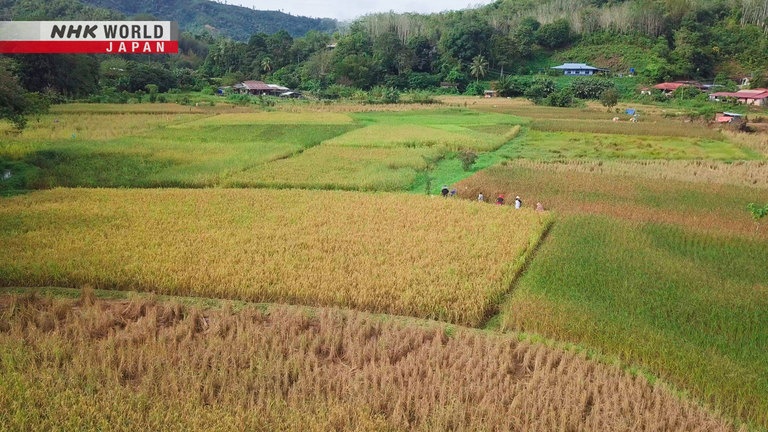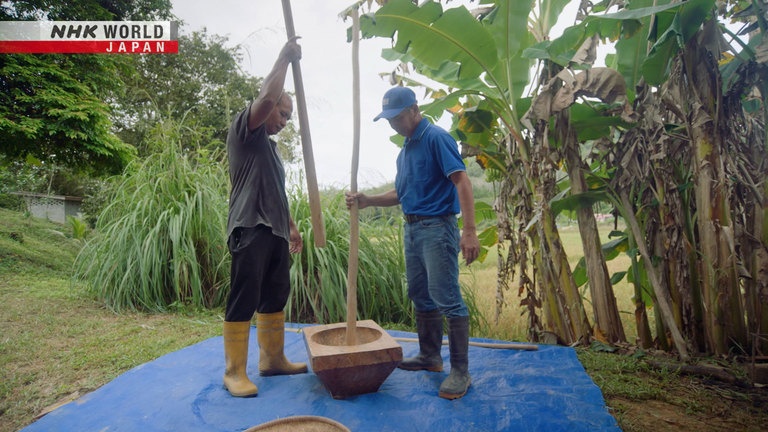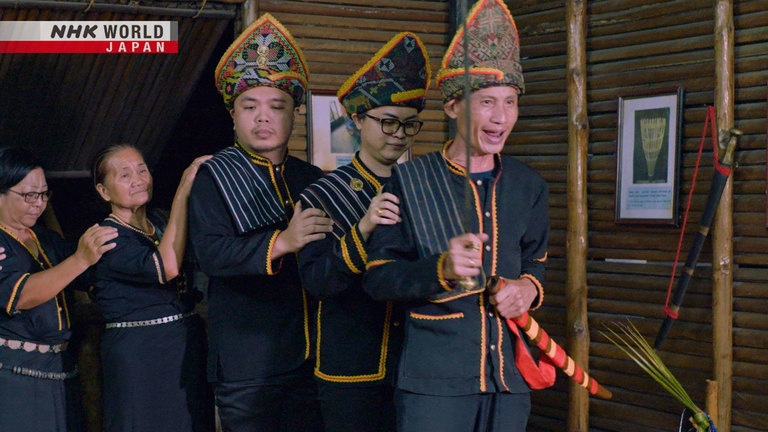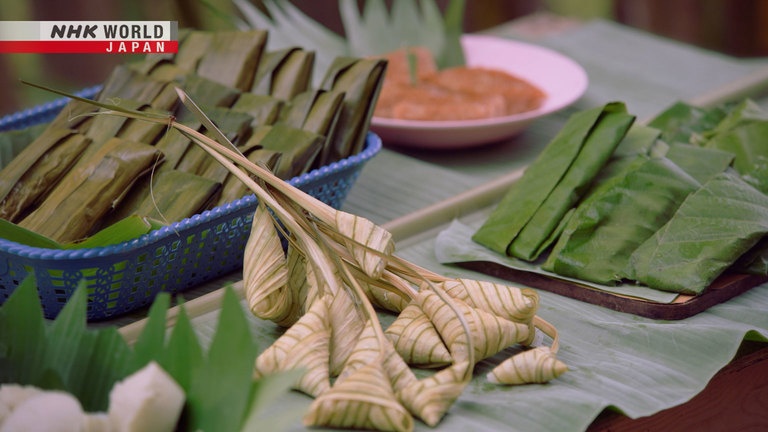Rice Heritage Revival: North Borneo, Malaysia
The Kadazan Dusun people of North Borneo, Malaysia, had been losing their tradition of rice farming with the passage of time, but new efforts are being made to preserve it through sustainable methods.




Transcript
The island of Borneo, located in East Malaysia.
Its northern state of Sabah is home to more than 30 indigenous peoples.
The most populous among them is the Kadazan Dusun,
an agricultural people who had been closely involved in rice cultivation.
However, in the course of modernization,
many of their fields have been assimilated into plantations growing cash crops such as oil palms.
Currently, North Borneo's self-sufficiency rate for rice is just 25%,
with most of the rice consumed in urban areas being imported.
The Dusun are quickly losing their tradition of rice farming.
In their lives, the farming had once been an important expression of community connectedness and indigenous culture.
Now, efforts are being made to rejuvenate rice production throughout the region.
This episode documents the people who plant the new seeds of rice farming in North Borneo.
West of Mt. Kinabalu, a famous symbol of Borneo, is the district of Tenghilan.
Here, a project has started to make use of abandoned fields in new rice farming efforts.
My name is Betroy Chiper bin Hongsui.
I come from a family of farmers in Lapasan.
Chiper is one of the leaders of the effort.
He had left his village to work in Kota Kinabalu, but he returned home after losing his job during the pandemic.
His reason for starting rice farming was something that concerned him about the village where he was born and raised.
When I returned to the village,
I noticed things had changed.
The community was fragmented,
and people didn't work together.
Everything required payment.
Farming households had become few, and only the elderly persisted in rice cultivation.
As he continued to farm rice, 65-year-old Bilu Pantai witnessed the changing face of the village.
When I was around eight years old,
my parents taught us how to plant rice.
In the 1960s, all the villages were planting rice.
There were no empty paddies here.
In the mid-1970s, young people started
going to the city to find other jobs.
In the 80s, people started to have
difficulty working in the fields.
The population had been aging.
The paddy fields started to be left uncultivated.
From the year 2000, many people stopped
planting rice, buying it from the store instead.
In this district, rice production resumed in 2020.
As COVID-19 swept through the world, one group took action.
When the country was hit
by COVID-19, rice was limited.
Each family was only allowed to buy
a 10 kg bag of rice at the time.
The villagers were very worried
during those days.
There was an initiative by the NGO Forever Sabah
to have the community replant rice paddies.
Cynthia Ong leads Forever Sabah with the goal of bringing about economic growth in Sabah.
Hello, how are you?
She was born in Sabah, but studied abroad in Europe,
after which she returned home to become an entrepreneur.
Her group is currently involved in more than 10 projects, with rice cultivation among them.
So I just asked the question, can we start planting on the rice fields?
Because traditionally there are a lot of rice fields here and many had stopped planting.
When they stopped planting rice, they lost a part of their identity.
Coming from a family that had farmed rice until his grandfather's generation,
Chiper was excited by the prospect of getting back to his roots.
During my childhood, I often played
with water buffaloes in the rice fields.
My grandfather and I fertilized the fields.
Those were unforgettable times.
We enjoyed the spirit of working together
without expecting anything in return.
I miss those important moments now.
I think when you have a culture of planting rice, which is very communal.
We eat together, plant together, prepare the land together, harvest together,
and then you lost that for 20 years or something.
You know a lot of the culture dies with it.
I actually didn't realize that because I've never planted rice before.
I didn't realize that there was so many cultural rituals and practices embedded in planting rice.
And that spirit was gone.
As a result of 3 years of work, the number of rice farming households has increased to 43,
and has become capable of harvesting 28 tons of rice.
As soon as they planted and the rice was growing, and the land started to look different.
They started to remember, like their bodies "Ah, this is what it's like."
And then the first harvest, you know everybody was so excited.
Those things as the rice grew, they connect with their identity because rice planting is part of their identity.
It's part of their culture.
The young people learned rice farming techniques from their elders.
The first step in processing rice is threshing.
We separate the grains from the stalks.
Then we dry the rice grain
until it's completely dry.
After that, we polish it to finish the rice.
The drying process may take anywhere from a full day to 2 or 3,
depending on factors like weather and humidity.
Most of the work here is performed by hand.
So much work went into this bowl of rice.
When I was part of that whole process for the first time,
I was like, wow, I'm gonna eat my rice like with this understanding that there was so much that went into.
You know, just this little bowl of rice.
I felt connected to the food in a different way.
I love the step by step ritual.
I think the work is real work.
One issue that arises in this project is
how rice cultivation can be profitable.
Activities towards marketing have emerged.
Farmers can sell surplus rice at a premium.
To market the rice, branding like
packaging and labels are needed.
The "Wagas Dati" in the logo means
"our rice" in a Dusun dialect.
Borneo is known for its diverse varieties of rice, which added strongly to the branding.
There are said to be about 35
types of rice from North Borneo.
Some from Sarawak, Ranau,
Tambunan Keningau, and Kota Belud.
How did the seeds reach here?
When there are weddings, people receive rice
from the spouse's region and plant it here.
They spread that way.
There's a type of rice
traditionally called "Lujuh."
Its color appears black.
When it ripens, it turns yellowish-orange,
but the steamed rice is white.
Another type we call
"Baragang," meaning red.
And "Rongguol" has an aroma like taro.
Having come to raise a wide array of rice, the Kadazan Dusun people extend this variety into their cuisine.
Ketupat
Glutinous rice is wrapped in palm leaves and boiled.
Ketupat
It symbolizes thanks to the farmers and unity among the community.
Ketupat
The sweetness of the rice stands out.
Tinapung
Banana is mashed and mixed with powdered rice and sugar.
Tinapung
It's then wrapped in banana leaves and steamed.
Tinapung
The scent of the leaves and its chewy texture can be enjoyed.
Tapai
Yeast is crushed and sprinkled on steamed rice, then fermented for two days.
Tapai
It's a traditional dessert with the flavor of rice wine.
There are also ways to serve fresh rice
simply by stir-frying it.
It makes a special snack only available
in the season when the fresh rice is harvested.
Growing a stable rice crop is by no means an easy job.
In Malaysia's warm climate, rice is usually harvested twice a year,
but this region only makes a single yearly harvest.
The greatest obstacle is water management.
There are no large rivers here to
obtain water for the rice fields.
The rain used to come in May or early June.
The time for planting was during those
months, but now it's unpredictable.
Sometimes there's too much rain,
and the paddy gets flooded.
In 2023, Borneo suffered unprecedented flooding, causing major damage to farms.
As we go into deeper into this journey,
we're looking at impacts of climate on rainfall, heat, temperature, floods.
All the kinds of things that will really impact yield for the farmers.
And we already saw that last year from 2023.
There is great impact from a changing climate and changing seasons on the farming cycle.
The experience of Covid as well as the experience last year of climate change
really showed us the vulnerability of our food system.
At the end of the harvest, the villagers celebrate the abundance and share a dinner together.
Tenghilan's return to rice farming has begun to restore the spirit of cooperation among the villagers
as they work and eat together as a group.
In North Borneo, measures are being taken to preserve traditional ceremonies in danger of being lost along with rice farming.
This is the Koisaan Cultural Village, a center established to transmit Kadazan Dusun culture and customs.
The Dusun people have long held a belief that spirits dwell in the rice,
and they perform an important ceremony after harvest in respect of them.
But with the drop in farming households, there are few priests left who can conduct the ceremony.
Priests from villages in the region gather here yearly to reenact the ceremony, preserving the indigenous culture.
Melvin Sebastian shares his knowledge with young locals.
Having worked in farming and become a priest at age 18, his wisdom is cherished.
I used to enjoy following my parents
to the fields and working.
I was always interested in planting,
so no matter how tired I felt, I was happy.
Harvesting rice feels like finding gold to me.
It's important that unlike when buying
rice, you eat what you grow yourself.
Magavau, our celebration of thanks to the rice,
reminds me how it brings life to us.
Bilu, who is assisting in the revival of rice production, recalls seeing the ceremony as a child.
My mother is the one always
called upon to perform a ritual.
It ensures the success of the paddies.
We communicate with the spirits of the
paddies, known as Bambarayon.
The spirits there bring abundance.
Magavau begins with everyone gathering in a circle to call forth the sprits of the rice.
This was once carried out as a group while walking among nature.
To the Kadazan Dusun people, rice farming is deeply linked to faith.
Legend tells that long ago, when the soil grew fallow and people suffered famine,
the god of the Dusun appeared before them.
The god sacrificed his own daughter, changing her fingers and head into food for the people.
Her body was transformed into rice paddies, and people were nourished by farming rice there.
It's this legend that brought about the belief in spirits existing within the rice and paddies.
Adam Gontusan works making accessories for traditional ethnic garb,
and with the wish of preserving Dusun culture, he began training as a priest at age 19.
Even though most Kadazan Dusun no
longer grow them, the paddies still exist.
So we believe that the spirits of rice still exist.
Because of that connection, we still appreciate
and pray to the spirits during Magavau.
The rice no longer comes from
the traditional granary.
It may be bought from the supermarket,
but it's still rice.
And the spirits are still there.
As factors like climate change and the war in Ukraine have driven up food prices worldwide,
ensuring food supplies has become a major concern.
Among these changes, one man has implemented new methods into the Dusun's traditional rice farming,
seeking to address the issues: Farming specialist Paul Chang.
He travels in person to impoverished regions in the countryside of North Borneo in order to spread sustainable farming.
I feel that giving back to the community by
cultivating crops is a divine mission for me.
I'm currently here promoting
a concept called "Faith Farm."
Faith is an acronym for
"Food Always In The House."
That means helping children in the rural
communities to be physically healthy.
Paul is a Malaysian of Chinese descent.
He moved to North Borneo to improve the lives of local people there, beginning his current efforts in 2021.
In 2022, the war in Ukraine
led to a global food crisis.
The price became too high
for some people to afford.
Another problem is processed
food lacking nutrition.
We focus on growing nutrition-rich
organic produce.
Not only is food lacking,
it's too expensive to purchase.
If people grow it themselves,
they can have good food.
As a practicing Christian, Paul made connections through the church with a new partner to work on the project.
This is Pastor Naimin of the Dusun people.
As a fellow farmer, he took a strong interest in Paul's ideals, and joined him in his effort.
Although they had a noble purpose in their goals, getting started wasn't easy for them.
The challenge for us is that
the project is community-based.
What we faced was the difficulty of
encouraging villagers to participate.
Many of them preferred to work
independently without supervision.
Since Dusun people living in rural areas tend to use rudimentary farming techniques,
Paul spread modern methods to help them become self-sufficient.
Indigenous people grew rice, but they
just scattered the seeds over the land.
It grew densely and competed for nutrients.
Then there was a pest infestation.
We introduced Sustainable
Intensification farming.
The method spaces each rice plant.
They're spread 30 cm apart so that
they don't compete for nutrients.
This brings about a far greater harvest.
In addition to the traditional paddy rice, they also grow upland rice in fields.
When upland rice matures, it grows as tall as a person,
meaning that the harvest needs to be performed by hand rather than machines.
Despite the difficulties inherent to upland rice,
Paul has suggested sustainable farming techniques suitable to them.
When we harvest the rice, we separate it
from the husks, making rice and rice bran.
The husks are burned into compost,
which restores the nutrients of the land.
After harvesting, we plant corn stalks.
Corn and rice consume different nutrients
without affecting each other.
We also grow pumpkins, and later use
the pumpkin and corn stalks for compost.
This prepares the land
for the next rice.
The corn can also be used to feed chickens.
Most of the farmers had been buying ready-made chicken feed.
Paul suggested instead using corn grown during the rice offseason as their feed.
Pastor Naimin raises chickens
in Tengkurus village.
He had been buying chicken feed.
He couldn't turn a profit because
the price of feed kept rising.
He was left with hundreds of grown chickens,
making it a costly and unstable business.
I managed to raise 600 chickens.
It was going well, but suddenly a disease struck,
and nearly all the chickens died.
Only 6 out of the 600 were left,
which was heartbreaking to me.
I had been cultivating corn,
and I said we could use it as feed.
I suggested that we work together growing
crops for feed and raising chickens.
Our concept is to create an entire self-sufficient
grain-to-food industry chain.
We grow our own feed, raise our chicks,
then use the manure to make compost.
Having all of these elements
within the community is our goal.
So that the Dusun people can gain greater independence in rice farming, Paul continues his work.
The modern era has placed a strain on the connection between people and nature.
The traditional rice farming of the Kadazan Dusun
has allowed them to remain close to nature while cherishing their community and culture.
To them, rice is more than a food source -
It's a symbol of abundance in life.